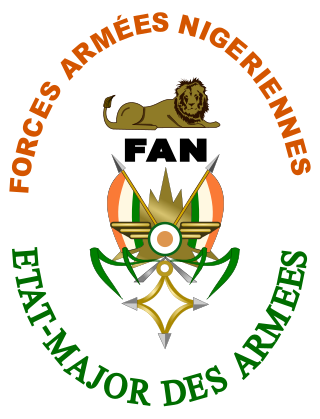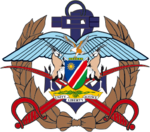
Namibia, officially the Republic of Namibia, is a country in Southern Africa. Its western border is the Atlantic Ocean. It shares land borders with Angola and Zambia to the north, Botswana to the east and South Africa to the east and south. Although it does not border Zimbabwe, less than 200 metres of the Botswanan right bank of the Zambezi River separates the two countries. Its capital and largest city is Windhoek.

The Niger Armed Forces includes military armed force service branches, paramilitary services branches and the National Police of Niger. The Army, Air Force and the National Gendarmerie are under the Ministry of Defense whereas the National Guard and the National Police fall under the command of the Ministry of Interior. With the exception of the National Police, all military and paramilitary forces are trained in military fashion. The President of Niger is the supreme commander of the entire armed forces. The National Assembly of Niger passed a statute for the Army of Niger in November 2020, planning for the army's size to increase from 25,000 personnel in 2020, to 50,000 in 2025 and finally 100,000 in 2030.

The Pakistan Armed Forces are the military forces of Pakistan. It is the world's sixth-largest military measured by active military personnel and consist of three formally uniformed services—the Army, Navy, and the Air Force, which are backed by several paramilitary forces such as the National Guard and the Civil Armed Forces. A critical component to the armed forces' structure is the Strategic Plans Division Force, which is responsible for the maintenance and safeguarding of Pakistan's tactical and strategic nuclear weapons stockpile and assets. The President of Pakistan is the Commander-in-Chief of the Pakistan Armed Forces and the chain of command is organized under the Chairman of the Joint Chiefs of Staff Committee (JCSC) alongside the respective Chiefs of staffs of the Army, Navy, and Air Force. All branches are systemically coordinated during joint operations and missions under the Joint Staff Headquarters (JSHQ).

The Papua New Guinea Defence Force (PNGDF) is the military organisation responsible for the defence of Papua New Guinea. It originated from the Australian Army land forces of the territory of Papua New Guinea before independence, coming into being in January 1973 and having its antecedents in the Pacific Islands Regiment. The PNGDF is a small force, numbering around 3,600 personnel, and consists of a Land Element, an Air Element and a Maritime Element. It is a joint force tasked with defending Papua New Guinea and its territories against external attack, as well as having secondary functions including national-building and internal security tasks.

The People's Liberation Army Air Force, also referred to as the Chinese Air Force (中国空军) or the People's Air Force (人民空军), is an aerial service branch of the People's Liberation Army. The Air Force is composed of five sub-branches: aviation, ground-based air defense, radar, Airborne Corps, and other support elements.
Lieutenant General Mweukefina Kulaumone Jerobeam Dimo Hamaambo was a Namibian military commander in both the Namibian War of Independence as a SWAPO member and in independent Namibia as the Chief of Defence in the Namibia Defence Force. He became the second commander of the People's Liberation Army of Namibia (PLAN) in 1967 after the death of Tobias Hainyeko and held the position until independence was gained in 1990.
Major General Petrus "Peter" Kagadhinwa Nambundunga was a Namibian military commander. Nambundunga was appointed the commander of the army in 2005, replacing Martin Shalli when he was promoted to chief of the Namibian Defence Force (NDF).
Lieutenant General Martin Shalli is a former Namibian diplomat and military commander. In 2005, he was appointed as Namibia's High Commissioner to Zambia by President Sam Nujoma, but he was recalled in October 2006 by Nujoma's successor, Hifikepunye Pohamba, and appointed as Chief of the Namibia Defence Force (NDF). He replaced controversial NDF commander Solomon Huwala, and he was replaced as High Commissioner to Zambia by regional councillor Solomon Witbooi.
Lieutenant General Epaphras Denga Ndaitwah is a Namibian diplomat and military commander. He was the chief of the Namibia Defence Force (NDF) from 24 January 2011 to 31 December 2013.

The Namibian Navy is the maritime warfare branch of the Namibian Defence Force.
Lieutenant General John Sinvula Mutwa was a Namibian military officer whose last appointment was as chief of the Namibian Defence Force (NDF). He was appointed the commander of the Namibian Army in 2011, and NDF Chief on 31 December 2013, a position from which he retired on 31 March 2020.

The Namibian Army is the ground warfare branch of the Namibian Defence Force.
Rear Admiral Sinsy Ndeshi Bamba Nghipandua is a retired Namibian military officer whose last appointment served was as the Commander of the Namibian Navy. He was appointed the Commander of the Namibian Navy in 2017. Prior to that he served as Commander of Naval Operations with the rank of Rear Admiral.

The Chief of the Defence Force (CDF) is the professional head of the Namibian Defence Force. He is responsible for the administration and the operational control of the Namibian military. The position was established after Namibia became independent in 1990. The current chief is Air Marshal Martin Pinehas, he succeeded Lieutenant general John Mutwa.
Major General Matheus Alueendo is a retired Namibian military officer who served as commander of the Namibian army. He was appointed the commander of the Namibian army on 31 July 2019 until his retirement 31 December 2022
Brigadier General Karel Christopher Ndjoba was a Namibian military officer whose last appointment was as Defence Attaché to Germany. His father Cornelius Tuhafeni Ndjoba was chief minister of Ovamboland.
The Joint Operations, Plans and Training Directorate is the branch of the Namibian Defence Force responsible for the force employment.
Brigadier General Fiina Fenni Amupolo is a Namibian military officer who is serving as the Defence Inspector General of the Namibian Defence Force (NDF).























